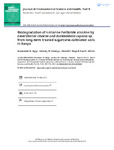Biodegradation of s-triazine herbicide atrazine by Enterobacter cloacae and Burkholderia cepacia sp. from long-term treated sugarcane-cultivated soils in Kenya

View/
Date
2011-09-26Author
Ngigi, Anastasiah N.
Getenga, Zachary M.
Boga, Hamadi I.
Ndalut, Paul K.
Metadata
Show full item recordAbstract
In this study soils from sugarcane-cultivated fields were screened for bacterial species capable of atrazine (6-chloro-N2-ethyl-N4isopropyl-1,3,5-triazine-2,4-diamine)degradationduetolongexposureofthesoilstothisherbicide.Toenrichforatrazinedegraders, Minimal Salt Medium containing atrazine as the sole N source and glucose as the C source was inoculated with soils impacted with this herbicide and incubated. Bacterial growth was monitored by measuring optical density. The degradation of atrazine was followed by measuring residual atrazine in liquid cultures over a given time period by high performance liquid chromatography. Bacterial strains isolated from the enrichment cultures were characterized by biochemical tests and identified by 16S rRNA gene sequencing. Two bacterial strains coded ISL 8 and ISL 15 isolated from two different fields were shown to have 94 and 96% 16S rRNAgenesequencesimilaritytoBurkholderiacepaciarespectively.Anotherbacterialsp.,ISL14wascloselyrelatedtoEnterobacter cloacae with a 96% 16S rRNA gene sequence similarity. There was not much difference between the extents of atrazine degradation by the enrichment cultures with communities (79–82% applied amount) from which pure strains were isolated and the pure strains themselves in liquid cultures that showed a degradation of 53–83% of applied amount. The study showed existence of bacterial strains in different sugarcane-cultivated fields which can use atrazine as a nitrogen source. The bacterial strains isolated can be used to enhance the degradation of atrazine in contaminated soils where atrazine is still considered to be recalcitrant
